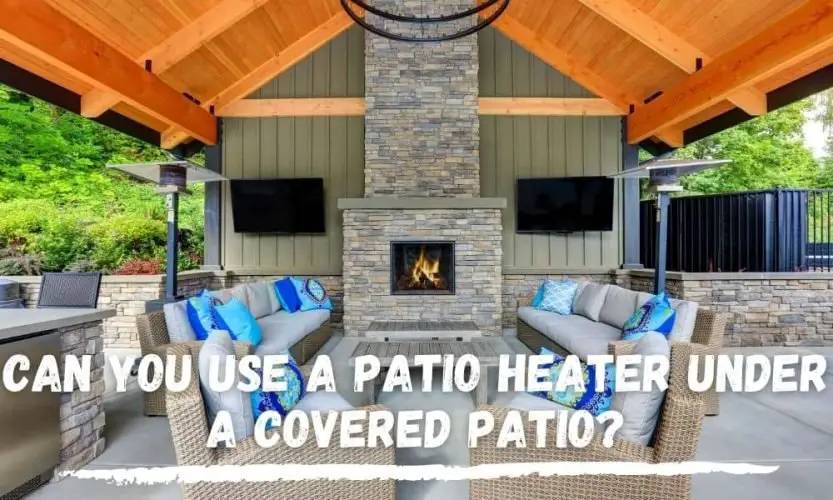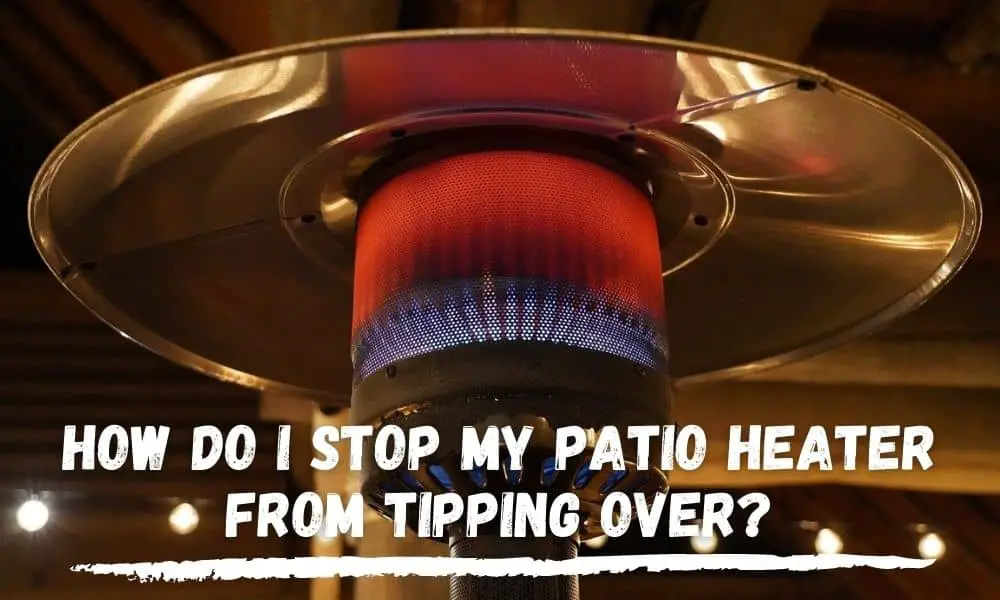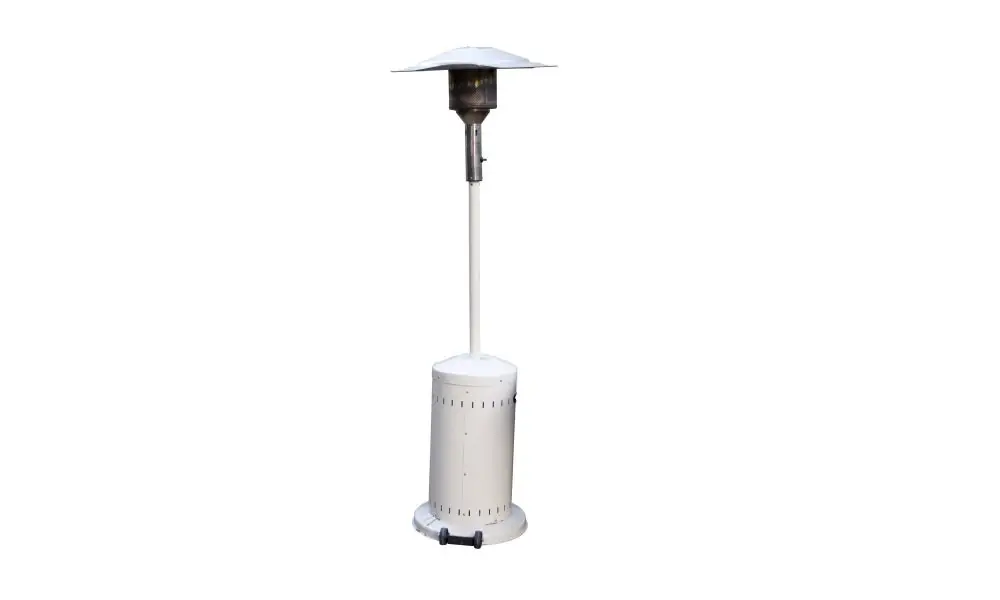After elegantly designing a covered patio, adding a heater can allow you to spend more time in it. Patio heaters are safe to use in covered spaces but under certain precautions.

You want your spaces to maintain a classy appearance. Therefore, avoid smoke-producing heating methods. These come with soot, creosote, and sparks that will spoil the look and can cause fires.
Below is a keener look into practices revolving around heater usage in sheltered spaces.
Quick Navigation
Can I Use a Patio Heater Under a Gazebo?
Yes, a patio heater is safe to use under a gazebo. However, outdoor heaters vary in terms of construction and design. When purchasing your patio heater, you should confirm that it features an enclosed design. The best outdoor heater to use is one that doesn’t have open flames.
Also, it should protect you and the people around you from coming to contact with direct heating.
Numerous eating joints, such as hotels and bars, use outdoor heaters under sheltered spaces. However, you will discover that they mostly rely on infrared and electric backyard units.
These types of patio heaters have an enclosed design for ample protection. Besides, once you connect them to power, you won’t get troubled finding and replacing fuel.
What Is the Best Patio Heater for Your Gazebo?
Since not all patio heaters are ideal for use in your gazebo, you should consider several things before getting one. Below are the vital factors you should make sure your patio heater meets before purchasing.
How Big Is Your Gazebo?
The dimensions of your gazebo will determine the type of outdoor heater you can use. Patio heaters have ratings expressed in kWh or BTUs depending on the type of fuel source. BTUs are for propane heaters while kWh for an electric backyard heater.
The more the number of BTUs or kWh your patio heater can supply, the more heat you can get. Also, a higher BTU or kWh rating results in faster heating.
If your gazebo is of a large size, go for a higher rating. This will ensure that all the people in the gazebo at any time feel warm and cozy. Alternatively, you can opt for less powerful models. However, you should purchase several of them and position them evenly around the gazebo area.
Pricing of a Patio Heater
Even if you want to save money, that should not mean you must settle for the cheapest patio heater available. Confirm first that your outdoor heater has adequate BTUs or kWh for ample heat supply.
The price of outdoor heaters varies depending on numerous factors. Outdoor space heaters may have similar construction but vary due to the brand. Therefore, don’t just rush for a famous brand. You may get the same deal at a lower cost from a lesser-known manufacturer.
The finishes and materials used may also affect the price of a patio heater. If you want a long-lasting outdoor heater, you may have to spend a little more for a high-quality constructed heater.
Prevailing Weather Conditions
When shopping for a patio heater, consider the season. You may purchase a patio heater that satisfies your heating needs right now but not later on. During warmer seasons, you may not need to raise the temperature so much. Hence, a lower power-rated outdoor heater may be sufficient for your needs.
But what happens during the coldest months, especially if it snows in your place? Getting a highly power-rated heater and then setting it at a low output level during warmer months is ideal. With a powerful outdoor patio heater, you can use your gazebo all year round.
Furthermore, look at wind conditions around your outdoor space. Considering the wind’s pressure and direction, you can decide on the perfect position in your gazebo to locate the heater.
If the gazebo area is quite windy, you should consider getting a small and lightweight outdoor heater. There are numerous quality and efficient small-sized tabletop heaters available.
The downside is that most small outdoor heaters have a lower rating hence may not be adequate to supply a big gazebo. But as earlier noted, you can use several backyard heaters to warm your gazebo adequately.
With a small outdoor heater, you can move it around depending on wind characteristics. Outdoor space heaters work similarly to the sun.
They generate heat, and the resultant infrared waves get transferred to objects. The amount of wind may not have a major effect on the amount of warmth felt.
The vitally of considering wind action is to eliminate a tipping risk. If you are using a heavy patio heater or a fixed one, it is challenging and tedious to reposition.
How Close Can a Patio Heater Be to the Ceiling?
Different Patio heaters will have different levels of clearance. If you have a massive heater that nearly touches or grazes your ceiling, that can result in a fire hazard.
Most outdoor heaters have a recommended clearance ranging from at least 24-36″. This clearance affects both around and above your heater. The type of heater you are using affects the level of clearance from the roof you need.
Electric patio heaters will need a minimum of about ½ foot. On the other hand, propane and natural gas patio heaters need a minimum of two roof clearance feet.
How Do You Heat a Covered Patio?
There are many ways of warming up covered patios. With many heaters available, you can get one to use under a covered space.
However, not all heaters are ideal for your sheltered space. Let us look at heater types that will work best under covered patios.
Type of Heater and Which Is Ideal for a Covered Patio
The usability of a heater under a covered patio depends on:
- The heater type.
- Your patio’s size.
Today, there are many heaters that you can use under covered patios. Below are three kinds and their performance under a covered patio.
Fixed Natural Gas Mushroom Heaters
Mushroom heaters are a popular choice because of their superb heat distribution. Moreover, they have an appellant shape.
These natural gas heaters rely on infrared heat mechanisms for transmittance. For this reason, mushroom heaters have no open flames that may quickly start fires. As a result, you can securely use them under your covered patio. However, ensure at least 2′ between the top of your natural gas heaters and your roof.
Many natural gas heaters are quite tall. Thus, you should install them in patios of about ten feet and over. Notably, these heaters have a permanent connection to natural gas lines. That means you can’t move them around upon installation.
Therefore, it would be best to get your mushroom heater installed close to the edge of your covered patio. This will offer you ample room to do other activities. However, remember to maintain a safe distance from the edges. Plus, you should have adequate space all around it to ease access to and from it.
Portable Propane Mushroom Heaters
Propane patio heaters may be the most common backyard heaters available, and do you know why? Besides having the advantages of the natural gas mushroom models, you can quickly move them around.
Also, propane tanks can stay for a while before requiring a replacement. So, they are better than wood-burning methods considering fuel sourcing.
Similar to natural gas mushroom units, they rely on radiant heat technology. They also have no open flame risk. Given that a standard mushroom model can be seven feet, you should use propane units in a patio with a roof at least ten feet high.
Angling your propane heater close to the open section of your outdoor patio is an excellent trick to use. It promotes enhanced heat dispersion, ensuring your covered patio is warmer.
Electric Mounted Heaters
Besides a covered patio, electric heaters are also usable indoors. Wall-mounted heaters have high anti-fire safety features that make them the perfect heaters for a covered patio.
Many of the electric heaters spread heat sideways rather than upwards. Because of this, amounted heater requires very little clearance from your roof. Half a foot is an adequate placement position.
Angling Heaters in Covered Spaces
Using a heater under your covered backyard area can protect your heater from rain and snow. However, patio heaters function maximumly without roofs over them. So how do you handle this dilemma if you want to get the most out of your heater?
Angling your heater near the open part of your covered space is crucial. This will aid in heat distribution. However, ensure that your hater doesn’t topple.
Toppling can quickly result in a fire. It is best to get a free-standing heater with an anti-tilt switch. Such a unit will cut the gas supply automatically in case it topples.
The Functionality of Backyard Heaters
To understand why it may be challenging to use these units under covered areas, let’s look at their functioning.
Air heaters will keep you warm by heating the air in the room. On the other hand, patio units employ radiant heat technology. Therefore, they directly warm objects around the room or the people around it without having to heat the air first.
Because of their radiant heating, they are excellent for both covered spaces and open areas. Air units may not function excellently in open areas, especially during windy conditions.
The only disadvantage of radiant heating is that some heat gets wasted on other objects. For instance, the roofs and walls which are expansive will take up some of the heat.
That is why angling your heater can help you maximize getting heat from it. However, a few models like the pyramid style may be difficult to angle.
Conclusion
It is clear that you can use these heaters not only on a covered patio but also indoors. However, make sure you maintain fire safety precautions when dealing with them. You should observe the clearance distance and ensure that your heater is stable.
Have a fire extinguisher or water source close by to eliminate any fire incidences.
Also, make sure you keep flammable materials far away. Finally, remember to get a heater that can supply adequate heat for your covered outdoor space.




